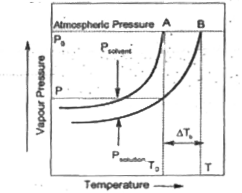Define Raoult's law for the elevation of boiling point of a solution.
Step-by-Step Text Solution:
1. Understanding Raoult's Law: Raoult's Law states that the vapor pressure of a solvent in a solution is directly proportional to the mole fraction of the solvent in the solution. This means that when a non-volatile solute is added to a solvent, the vapor pressure of the solvent decreases.
2. Elevation of Boiling Point: The boiling point of a solution is the temperature at which its vapor pressure equals the atmospheric pressure. When a solute is added to a solvent, the vapor pressure of the solvent decreases, which means that a higher temperature is required to reach the atmospheric pressure.
3. Relation to Vapor Pressure: According to Raoult's Law, the lowering of vapor pressure (ΔP) is directly proportional to the number of solute particles present in the solution. This can be mathematically expressed as:
ΔP=P0−P=Kb⋅m
where P0 is the vapor pressure of the pure solvent, P is the vapor pressure of the solution, Kb is the ebullioscopic constant, and m is the molality of the solution.
4. Boiling Point Elevation Formula: The elevation in boiling point (ΔT_b) can be calculated using the formula:
ΔTb=Kb⋅m
This indicates that the elevation in boiling point is directly proportional to the molality of the solution and the ebullioscopic constant of the solvent.
5. Conclusion: In summary, Raoult's Law for the elevation of boiling point states that the elevation in the boiling point of a solution is directly proportional to the lowering of vapor pressure caused by the number of solute particles present in the solution.
---
ΔP=P0−P=Kb⋅m
where P0 is the vapor pressure of the pure solvent, P is the vapor pressure of the solution, Kb is the ebullioscopic constant, and m is the molality of the solution.
ΔTb=Kb⋅m
This indicates that the elevation in boiling point is directly proportional to the molality of the solution and the ebullioscopic constant of the solvent.
Topper's Solved these Questions
- SOLUTIONSBOOK - ICSECHAPTER - SOLUTIONSEXERCISE - ISC EXAMINATION QUESTIONS (PART-II Descriptive Questions) (Numerical Problems)
14 Videos
- SOLUTIONSBOOK - ICSECHAPTER - SOLUTIONSEXERCISE - MULTIPLE CHOICE QUESTIONS
23 Videos
- SOLUTIONSBOOK - ICSECHAPTER - SOLUTIONSEXERCISE - ISC EXAMINATION QUESTIONS (PART-I Objective Questions) (Choose the correct alternative)
8 Videos
- SOLID STATEBOOK - ICSECHAPTER - SOLID STATEEXERCISE - ISC EXAMINATION QUESTIONS PART-I (Numerical Problems)
6 Videos
- SOME IMPORTANT ORGANIC NAME REACTIONS BOOK - ICSECHAPTER - SOME IMPORTANT ORGANIC NAME REACTIONS EXERCISE - Questions
278 Videos
Similar Questions
Define boiling point
View SolutionDefine normal boiling point of a liquid.
View SolutionIf two liquids A(boiling point=t1°C)and B(boiling point=t2°C) on mixing forms azeotropic solution which shows positive deviation from Raoult's law, then boiling point of azeotropic solution will be [Given,t1>t2]
View SolutionConsider following figure and answer the questions at the end of it. Figure explains elevation in boiling point when a non-volatile solute is added to a solvent.

Variation of vapour pressure with temperature and showing elevation in boiling point.
Given that ΔTb is the elevation in boiling point of the solvent in a solution of molality m then Ltm→0(ΔTbm) is equal to
View SolutionFor a dilute solution containing a nonvolatile solute, the molar mass of solute evaluated from the elevation of boiling point is given by the experssion:
View SolutionIf ΔT is the elevation in boiling point of a solvent and m is the number of moles of the solute per kilogram of solute, what is the relationship between ΔT and m?
View SolutionExplain Raoult's law for a solution containing non-volatile solute.
View SolutionAccording to Raoult's law the relative lowering of vapour pressure for a solution is equal to
View SolutionDerive the relation between elevation of boiling point and molar mass of the solute .
View SolutionBoiling point elevation is
View Solution
